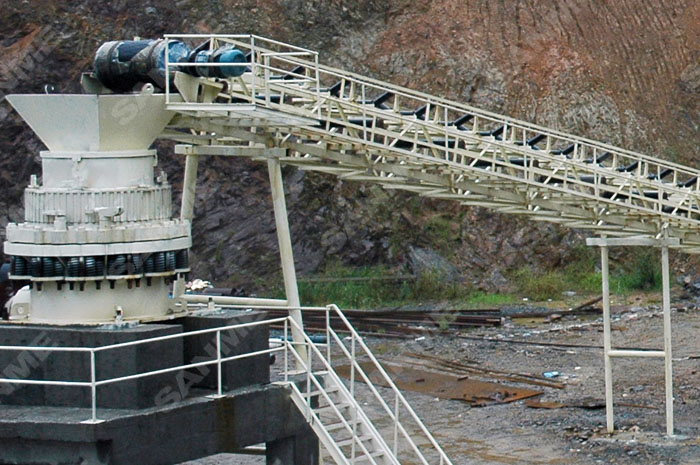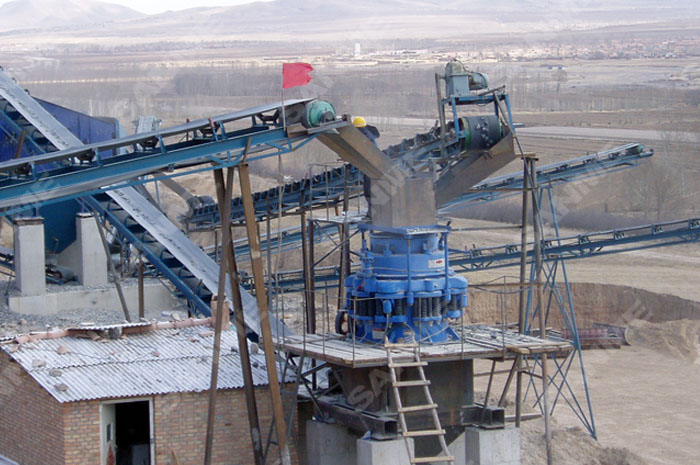
400Kw Metallurgy Feeding 460mm Cone Crusher Machine
2025-8-19
A compound cone crusher is a comprehensive cone crushing device that combines spring and hydraulic cylinder technology. Its core feature is the synergy of these two systems for efficient crushing and intelligent protection. The following analysis focuses on four aspects: technical principles, structural advantages, performance characteristics, and application scenarios:
1. Technical Principle: Spring and Hydraulic Composite Protection Mechanism
Spring System
Overload Protection: When uncrushable objects (such as metal blocks) enter the crushing chamber, the spring is compressed to increase the size of the discharge opening, allowing the foreign object to be discharged and automatically reset, preventing mechanical damage.
Base Support: Provides basic elastic force to ensure stable operation under normal operating conditions.
Hydraulic System
Hydraulic Cavity Clearing: A hydraulic cylinder quickly clears residual material from the crushing chamber, reducing downtime.
Discharge Opening Adjustment: A hydraulic device precisely adjusts the discharge opening size to accommodate different particle size requirements.
Overload Enhancement Protection: Works with the spring system to provide dual protection in extreme overload situations.

2. Structural Advantages: Modular and High-Strength Design
Modular Structure
Key components (such as the crushing cone, fixed cone, and adjustment device) adopt a modular design, facilitating quick assembly and disassembly, as well as maintenance.
Tapered roller bearings are installed on both ends of the drive shaft, and heavy-duty bevel gears provide power, ensuring transmission efficiency and stability.
High-Strength Materials
The main body is constructed of cast steel, with reinforced ribs in heavy-load areas to enhance impact resistance.
Inner and outer copper sleeves (i.e., inner and outer copper) are mated with steel spherical seats to reduce wear and extend service life.
Sealing and Lubrication System
The bearing seats utilize skeleton-type seals to prevent lubricant leakage.
The external lubrication system (including the oil pump, oil tank, and piping) monitors oil temperature and flow rate in real time, automatically shutting down the machine for protection in the event of an abnormality.
3. Performance Features: High Efficiency, Stability, and Low Energy Consumption
High-Efficiency Crushing
Laminated Crushing Principle: The material undergoes multiple compression, impact, and bending within the crushing chamber, resulting in uniform particle shape and low needle-like content.
Optimized Crushing Frequency and Eccentricity: Dynamically adjust parameters to achieve higher crushing efficiency and higher output. For example, the VSC series compound cone crusher’s combination of crushing frequency and eccentricity can increase production capacity by 10%-15%.
Operational Stability
Dual safety system: Spring and hydraulic linkage protection ensures a failure rate of less than 5% and a trouble-free operation rate exceeding 95%.
Dust-proof design: The dust shield is spring-loaded and automatically adjusts during operation to prevent dust from entering key components.
Low energy consumption and maintenance costs
Efficient lubrication system: Reduces equipment cycle load and extends the life of key components.
Quick maintenance: The modular structure reduces maintenance time by 30%-50%, reducing operating costs.

4. Application Scenario: Crushing Solutions Covering Multiple Industries
Mining Industry
Suitable for coarse, medium, and fine crushing of high-hardness materials such as iron ore and non-ferrous metal ores.
Short-head compound cone crushers produce fine-grained materials to meet mineral processing needs.
Building Materials and Metallurgy Industry
Processes medium-hardness materials such as granite, limestone, and quartzite to produce sand and gravel aggregates for construction. High-efficiency hydraulic compound cone crushers (such as the HP series) are suitable for medium-to-fine crushing of ores with a Pugh hardness of ≤5-16.
Environmental Protection and Construction Industries
Crushing construction waste, the feed flow control system and sorting mechanism separate impurities to prevent equipment stalls.
They meet the high demands for finished product particle size uniformity in concrete batching plants, dry mortar production lines, and other applications.